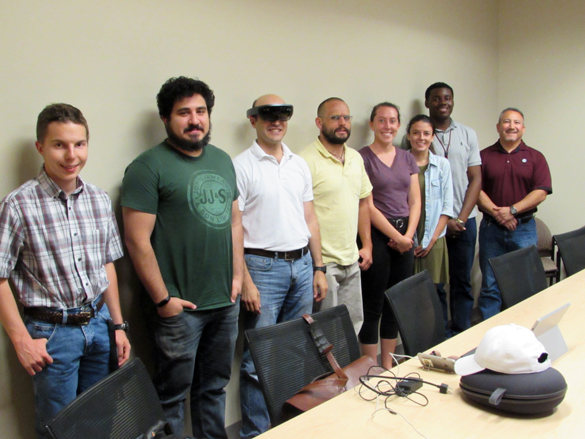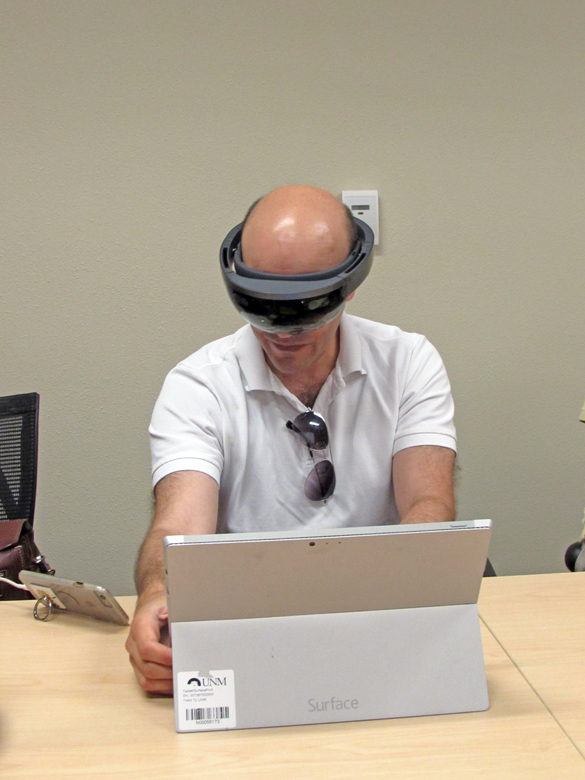 From left, UNM student Ben Narushof, UNM post-doctorate Ali Ozdagli, UNM Assistant Professor Dr. Fernando Moreu, LANL Engineering Institute’s Dr. David Mascarenas, first year doctoral student JoAnn Ballor from Michigan, University of California in San Diego student Miranda Mellor, Southern University and AM College student Oscar McClain and County Engineer Eric Martinez are partnering to test hololens, which are being modeled by Moreu. Photo by Kirsten Laskey/ladailypost.com
From left, UNM student Ben Narushof, UNM post-doctorate Ali Ozdagli, UNM Assistant Professor Dr. Fernando Moreu, LANL Engineering Institute’s Dr. David Mascarenas, first year doctoral student JoAnn Ballor from Michigan, University of California in San Diego student Miranda Mellor, Southern University and AM College student Oscar McClain and County Engineer Eric Martinez are partnering to test hololens, which are being modeled by Moreu. Photo by Kirsten Laskey/ladailypost.com
 UNM Assistant Professor Dr. Fernando Moreu demonstrates how hololens work. Photo by Kirsten Laskey/ladailypost.com
UNM Assistant Professor Dr. Fernando Moreu demonstrates how hololens work. Photo by Kirsten Laskey/ladailypost.com
By KIRSTEN LASKEY
Los Alamos Daily Post
kirsten@ladailypost.com
Wearing an electronic headset over his eyes, Dr. Fernando Moreu, an assistant professor at the University of New Mexico’s (UNM) Civil Engineering, seemed to be modeling technology that could only exist in the very distant future and on board the Star Trek Enterprise.
Yet hololens exist in present time and are being utilized by Los Alamos National Laboratory (LANL), Los Alamos County Public Works Department and a group of college interns for some very practical means. Since June, the County has been involved in the research and development phase of hololens through a partnership with LANL, UNM and a group of LANL summer interns. New Mexico Consortium (NMC) and its director Steve Buelow have also provided support. Dr. David Mascarenas from the Engineering Institute of LANL has worked with Dr. Moreu and UNM’s students since the fall of 2016 in advancing the application of this technology to real civil engineering applications, such as collecting measurements in the field that informs owners about the condition of their infrastructure.
Hololens, Moreu and Mascarenas explained, is technology that utilizes augmented reality. It creates holograms and allows the user to interact with them. They said augmented reality is different than virtual reality because it produces a virtual object in the real world. By wearing the headset, which comes equipped with a depth camera and speakers, the user can talk with it and interact with the technology using their hands.
The uses for this technology are wide and varied. It can be used to do everything from inspect a chimney to measuring irregularities in sidewalks.
Moreu pointed out hololens offers some pretty sci-fi capabilities. For instance, if a person wanted to inspect several bridges at once, they could so by overlaying the bridge images. He described it as teleportation.
He emphasized this is extremely new technology and not a lot of people know about it.
County Engineer Eric Martinez explained Public Works is helping test the hololensmeasuring and mapping capabilities.
He said we’ve field tested the hololens on a road construction site utilizing its measuring application to field measure newly constructed irregularly shaped concrete surfaces.
These measurements are used to reconcile the actual quantity of material placed which in turn ensures accurate payment for the work.
Martinez said they are able to do side by side comparisons of the hololens’ measurements versus the department’s traditional methods. He said normally measurements are collected with a measuring tape or wheel, but in the case of more complex irregular shapes, a two-man survey crew and equipment are deployed to collect field data which is then taken to the office and entered into computer aided drafting software to compute areas of material placed By contrast, hololens technology can be operated by one user and provides instant measurements.
Martinez said right now the technology is in a testing phase and other applications for hololens are being pursued. He mentioned another application undergoing testing is determining the slope of sidewalks to meet ADA compliance and ensuring surfaces and drainage structures are built to the proper slope to function properly for drainage conveyance.
Martinez said the testing phase has been going great. “So far it’s been a great learning experience for us and a remarkable team effort.”
LANL’s Dr. David Mascarenas commented the County is a great place to test out this new technology. “It’s good to work with the County because they have actual applications and they have data from their work that we can compare,” he said. Mascarenas is mentoring the interns along with Alessandro Cattaneo and Troy Harden from LANL.
Martinez said, “It’s always useful to have state of the art technology to be more efficient in our operation which can ultimately save taxpayer money and helps to better utilize our limited resources.”
He added, “We appreciate this collaboration with UNM and LANL … we get to experience really amazing state-of-the-art tools … and this helps us progress.”
Moreu said it is also beneficial to the summer interns. Students are exposed to national laboratories and real public service, he said, adding, “it’s the best education they can receive.”
The interns involved in the program include JoAnn Ballor, a first year doctoral student from Michigan, Miranda Mellor from the University of California in San Diego, Oscar McClain from Southern University and AM College, Ben Narushof of UNM and Ali Ozdagli, a post doctorate from UNM.
Ballor said having experience with research through the laboratory has really completed her education.
Mellor added, “I really enjoyed getting to work with cutting edge technology. It’s been a really good experience.”
McClain said he is a chemistry major and the experience working with hololens has exposed him to something new.
Narushof said, “It’s very neat to have this experience. Just relating the experience with real cutting edge technology.”
Moreu added that in this situation, everyone wins. “This summer, Los Alamos County Public Works Director Philo Shelton helped UNM during their summer transportation institute program, explaining high schoolers the concept of smart transportation systems. Shelton explained to future engineers how innovation is applied to real applications, using the Los Alamos Transit Phone Application as an example.”
Moreu said the County’s support is meaningful to the students and having the students receive this training is important “because they are the future engineers. Their experience here will apply to future careers.” UNM, LANL, NMC, and LAC plan to continue working together towards serving New Mexico’s infrastructure through education, research, and industry implementation. Moreu added that with LANL and NMC’s support, one UNM computer science student will present the results of their work to Stanford’s International Workshop in Structural Health Monitoring this September.

